Research and Publications
|
|
Next Generation Lighting Systems OverviewOnline education model taking viewers inside the Department of Energy Next Generation Lighting Systems Program. This video provides an overview of the program's purpose and research methodologies. The video was produced by Akoya for the Next Generation Lighting Systems Program. |
Modeling a new approach to the design of lighting controls (workshop, may 2023)Too often the design of lighting controls begins with a favored proprietary system. This tends to limit choices, especially for those without deep controls experience. But it doesn’t have to be this way. This presentation models an interactive decision framework, an alternative independent of specific manufacturer systems. The materials how controls objectives suggest appropriate system capabilities, how technology variables shape cost and risk parameters, and how system architectures support or limit the desired outcomes. |
|
Selecting Lighting Control Systems (November 2022)This guide provides a systematic approach to determining controls objectives, system capability considerations, networking and communication options, and documentation needs – helping decision makers select lighting control systems to satisfy project objectives. |
|
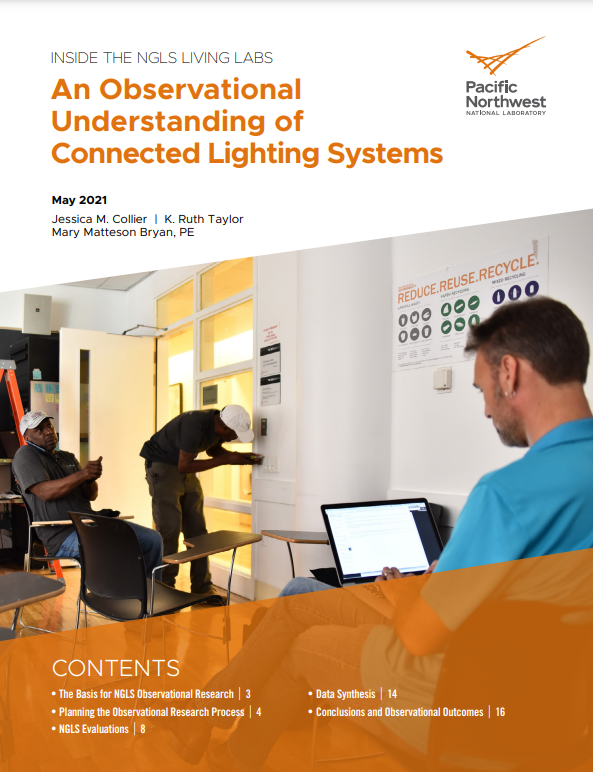 |
An Observational Understanding of Connected Lighting Systems (Report, May 2021)As part of the Internet of Things (IoT), connected lighting systems provide additional control capabilities and nonlighting-related services (such as communications and data infrastructure) to reduce energy use while increasing both application efficiency and system value. But the positive or negative energy impact of implementing these systems is still largely unknown due to the variety of human factors associated with installation, maintenance, and use. These complications interfere with adoption and acceptance rates of products that will play a significant role in achieving energy savings long-term. Next Generation Lighting Systems, or NGLS, developed and implemented an observational research methodology for connected lighting systems. The methodology was implemented at an indoor (classroom/office) Living Lab at Parsons School of Design in New York City, and an outdoor (parking lot) Living Lab at Virginia Tech Transportation Institute in Blacksburg, Virginia. Although this report focuses on the approach to indoor installations, observational research in both settings provides insight to the type, scale, and frequency of issues across available products as experienced by installing contractors, end users, and other stakeholders. |
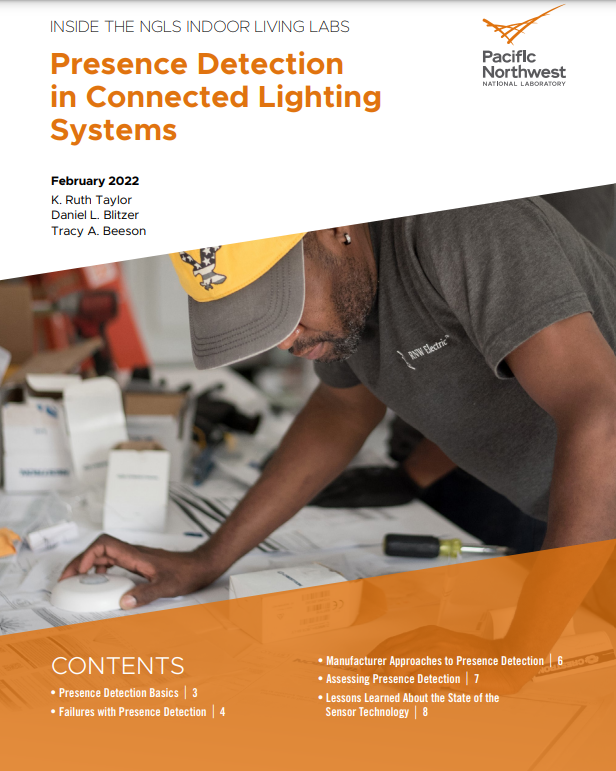 |
Presence Detection in Connected Lighting Systems (Report, February 2022)Despite established technology and decades of experience, presence detection still faces challenges, including resistance to its use. This report provides context for current presence detection in lighting, considers various failure modes and their causes, characterizes various approaches to implementing presence detection, and describes performance evaluation as conducted in classrooms and offices at the Living Lab. |
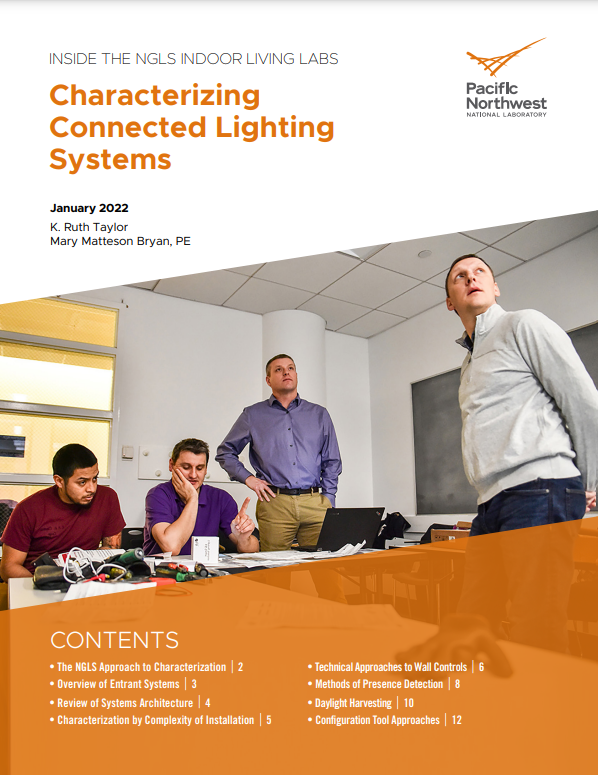 |
Characterizing Connected Lighting Systems (Report, January 2022)In the context of evaluating a lighting control system, characterization refers to the identification and description of key attributes and distinctive features of that system. NGLS has to date characterized both the form and function of 14 lighting control systems installed in the Living Lab at Parsons School of Design in New York City. The goal of NGLS characterizations in the Living Lab has been to achieve a broad understanding of “these types of systems” as a class, rather than a detailed description of any individual system. |
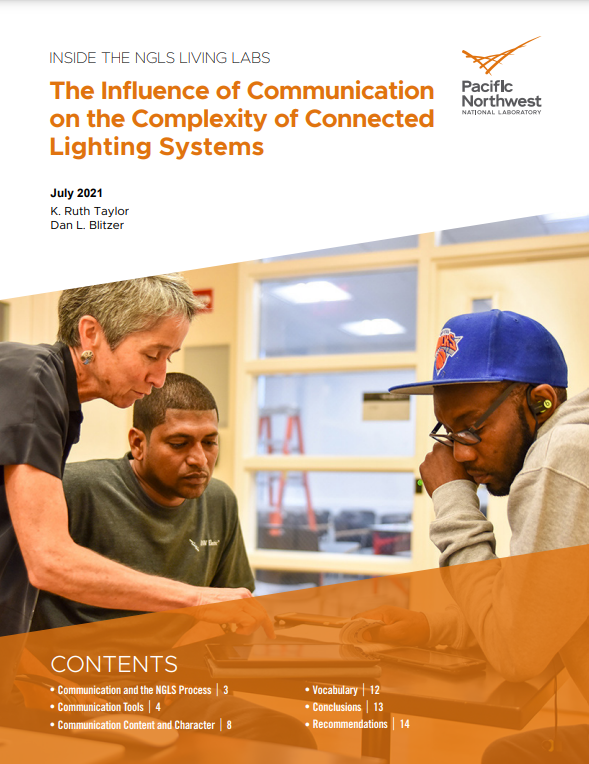 |
The Influence of Communication on the Complexity of Connected Lighting Systems (Report, July 2021)Experience in the Next Generation Lighting Systems (NGLS) ”Living Lab” at the Parsons School of Design, has clearly shown the impacts of communication on the configuration complexity of the connected lighting systems installed there. Since 2017, NGLS has invited manufacturers to submit connected lighting systems for assessment against a set of specifications. To date, 14 systems of wirelessly connected LED luminaires and controls have been installed in classrooms with existing lighting. In nine of the rooms, new LED linear pendants or recessed troffers replaced existing luminaires; in the other rooms, LED “kits” were retrofitted into the existing troffers. Eleven of the installations featured sensors integrated in the luminaires or retrofit kits; the others used ceiling mounted sensors. All systems provided wall control devices for manual operation. For half of the installations, the complete systems were furnished by single companies; for the other half, luminaires and controls were furnished by separate companies. A total of 18 different companies provided products, with four of these located outside the United States including Korea, Poland, Germany, and the Netherlands. In addition, two different electrical contractors in New York City provided multiple installation teams totaling 10 individuals, none of whom were familiar with any of the systems.
|
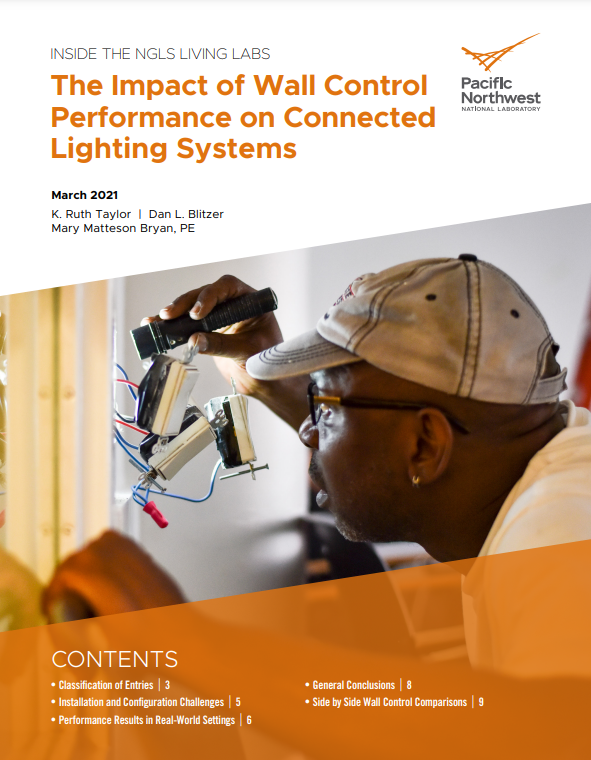 |
The Impact of Wall Control Performance on Connected Lighting Systems (Report, March 2021)Wall controls form the only touchpoint for individual room users and that room’s lighting control system. As such, these interfaces strongly influence user understanding and utilization of the system, as well as overall acceptance. The Next Generation Lighting Systems (NGLS) program began an evaluation of the wall controls in 14 connected lighting systems installed in various rooms of the NGLS Living Lab at Parsons School of Design in New York City. These systems demonstrate the wide range of approaches to wall control setup and functionality taken by manufacturers. Characterizing the 14 controls across six attributes, only four, or 29%, were identical. Requirements for wall control design were not specified explicitly by NGLS. Rather, wall controls were required to provide system performance according to three criteria: vacancy control (manual on/auto off) of two zones; manual continuous dimming of the same two zones; and an AV presentation mode in one of the two zones. This report examines the classification of entries, the assessment method used to evaluate the systems from installation through day-to-day use, and the system performance observed to date for each.
|
More Resources
| April 2023 | Rethink It: A new approach to selecting lighting control systems Ruth Taylor, Pacific Northwest National Laboratory LD+A Magazine https://www.ies.org/lda-magazine |
| Promise Vs. Practice: Are Lighting Controls Closing the Gap? Ruth Taylor, Pacific Northwest National Laboratory EC&M magazine www.ecmweb.com |
|
| December 2022 |
Loss and Profit from Today’s Lighting Controls |
| April 2022 | Something’s Got to Give: The Issues Dogging Connected Lighting Systems Still Persist Ruth Taylor, Pacific Northwest National Laboratory LD+A Magazine https://www.ies.org/lda-magazine |